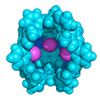| Jul 28, 2025 |
Researchers efficiently synthesize functionalized oligophenylene cages using covalent templates and cooperative intermolecular coupling.
(Nanowerk News) Template-assisted synthesis dramatically improves the yield of functionalized oligophenylene cages, report researchers from Japan. By using covalent templates to guide a six-fold Suzuki–Miyaura cross-coupling reaction, the researchers achieved significantly higher yields of around 68% in comparison to conventional methods, which struggle to exceed a 10% yield. The resulting molecular cages feature tailored cavities with inward-facing OH and NH2 groups for selective molecular encapsulation—opening new avenues for host-guest chemistry and catalysis.
|
|
Molecular cages are hollow, three-dimensional, cage-like structures that can entrap other molecules inside them. For decades, chemists have sought to develop stable molecular cages, especially oligophenylene cages, which stand out due to their chemical resilience and unique structural properties. Yet, traditional methods often fall short in the synthesis of oligophenylene cages—particularly their endo-functionalized versions (which have precise functional groups present inside their cages)—requiring complex cyclization processes with low yields.
|
|
In this context, a research team led by Associate Professor Kosuke Ono from the Department of Chemistry, Institute of Science Tokyo (Science Tokyo), Japan, has now introduced a highly efficient template-guided method for the stable synthesis of endo-functionalized oligophenylene cages. The findings of the study were made available in the Journal of the American Chemical Society (“Covalent Template-Guided Synthesis of <i>endo</i>-Functionalized Oligophenylene Cages”).
|
 |
| This study demonstrates the template-driven approach unlocking efficiency in synthesis and an increase in yield, opening avenues for the development of stable host materials. (Image: Institute of Science Tokyo) (click on image to enlarge)
|
|
“Oligophenylene cages have excellent stability, thanks to the chemically robust phenylene frameworks,” explains Ono, “However, constructing these cages requires simultaneous and precise formation of numerous covalent bonds, which often lowers the final yield of cages in conventional synthesis.”
|
|
To overcome the same, the researchers devised a strategic approach using a covalent molecular template. Specifically, they first prepared a molecular cage precursor in which three oligophenylene units (quinquephenyl diboronic esters) were used as pillars. These pillars were connected using a template molecule, which guided the cage assembly. The formed cage precursor was then joined with two floor components (1,3,5-tribromobenzene units) on the top and bottom to complete the cage structure.
|
|
While the process resulted in six specific covalent bonds, the team discovered that their technique led to cooperative bond formation, supporting the simultaneous formation of multiple chemical bonds via Suzuki–Miyaura coupling (a palladium-catalyzed reaction). This simultaneous formation of bonds facilitates the overall reaction. Once the cages were formed, the researchers removed the template molecule. This uncovered the protected functional groups such as hydroxyl (OH) and amino (NH₂) groups within the internal cavity, ultimately leading to endo-functionalized cages.
|
|
“Our approach marks the first efficient synthesis of oligophenylene cages with modified internal spaces—an area previously unexplored,” remarks Ono.
|
|
In contrast to the yields of conventional methods (only 1–7%), this template-guided synthesis produced molecular cages in remarkably higher yields: about 68% for hydroxyl-functionalized groups and 36% for amino-functionalized groups. This dramatic increase in efficiency was driven by the dual role of the template; firstly, the template-led precursor resulted in close proximity between the reacting groups, which promotes the bond formation. Secondly, the template also acted as a protective group, shielding the functional groups during bond formation.
|
|
Further, the team confirmed the lantern-shaped architecture of the cages using single-crystal X-ray diffraction, revealing the precise orientation of functional groups towards the interior cavity. These functionalized spaces also enabled the selective entrapment of guest molecules, including L-tryptophan methyl ester in OH-functionalized cages and diphenyl phosphate in NH2-functionalized cages, showcasing the distinct molecular recognition capabilities of the structures.
|
|
“Being able to fine-tune the internal environment of these cages offers new control over molecular interactions,” notes Ono. “This is not just synthetic progress, but a doorway to new chemistry, leading to the development of stable, functional organic host materials.”
|
|
Bridging the gap between design precision and synthetic scalability, the study marks a significant milestone in molecular cage chemistry. As the researchers continue to refine these architectures, the method sets the stage for transformative applications in supramolecular catalysis, sensing technologies, and molecular transport—tailoring host environments for improved performance and innovations.
|


